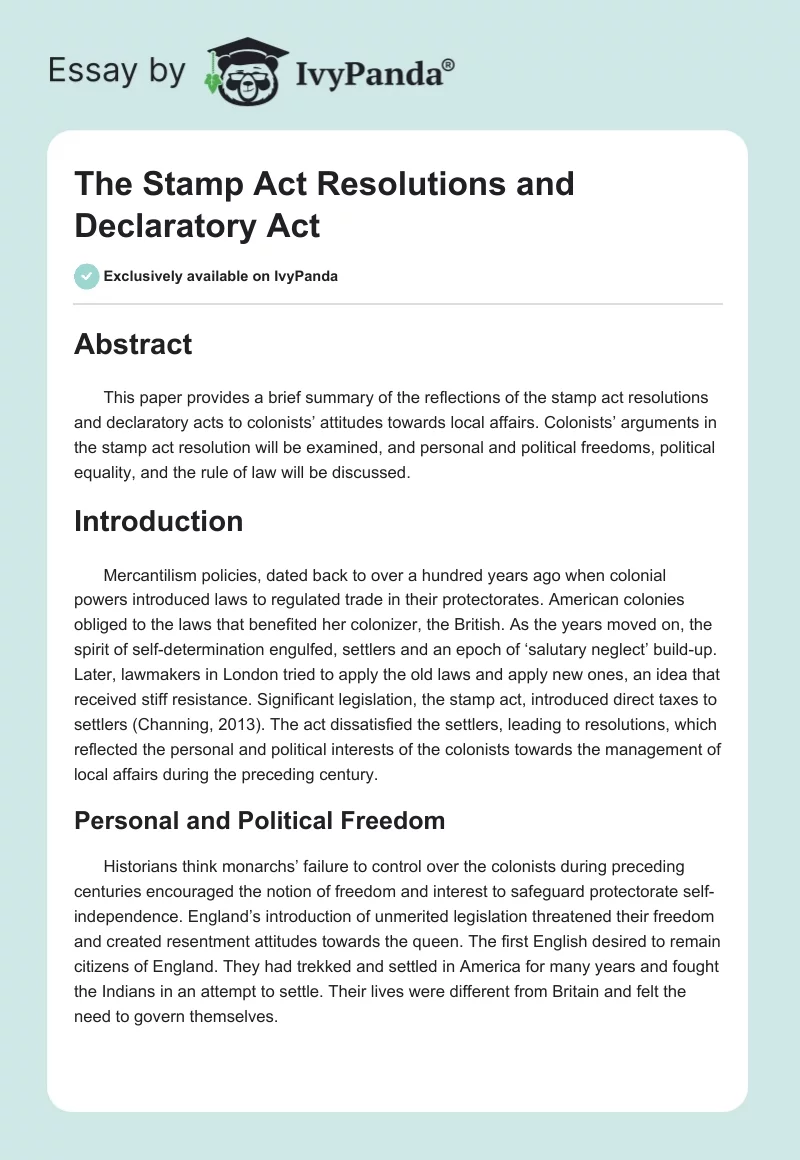Abstract
This paper provides a brief summary of the reflections of the stamp act resolutions and declaratory acts to colonists’ attitudes towards local affairs. Colonists’ arguments in the stamp act resolution will be examined, and personal and political freedoms, political equality, and the rule of law will be discussed.
Introduction
Mercantilism policies, dated back to over a hundred years ago when colonial powers introduced laws to regulated trade in their protectorates. American colonies obliged to the laws that benefited her colonizer, the British. As the years moved on, the spirit of self-determination engulfed, settlers and an epoch of ‘salutary neglect’ build-up. Later, lawmakers in London tried to apply the old laws and apply new ones, an idea that received stiff resistance. Significant legislation, the stamp act, introduced direct taxes to settlers (Channing, 2013). The act dissatisfied the settlers, leading to resolutions, which reflected the personal and political interests of the colonists towards the management of local affairs during the preceding century.
Personal and Political Freedom
Historians think monarchs’ failure to control over the colonists during preceding centuries encouraged the notion of freedom and interest to safeguard protectorate self-independence. England’s introduction of unmerited legislation threatened their freedom and created resentment attitudes towards the queen. The first English desired to remain citizens of England. They had trekked and settled in America for many years and fought the Indians in an attempt to settle. Their lives were different from Britain and felt the need to govern themselves.
Settlers considered the declaratory act illegal because it restricted them to British rule, and violated their personal and political freedoms (Channing, 2013). In addition, England had absolute powers to approve any law and thus undermining democracy. The colonists felt the need of enjoying the freedom of expression through political representation. Their rights to expression through fair distribution in the parliament were overpowered. Consequently, they were not liable to decisions reached in the absence of representation leading to the slogan “No taxation without representation” that seemed to sustain a democratic appealing. In addition, settler’s freedoms and rights of protecting the property from unfair taxation were limited.
Perhaps, the American colonies would have corresponded with the colonial masters, but they felt the desperate need to boast a say in decisions affecting their nation through voting about their own taxes, just as their opposite numbers in Britain. The declaratory act instigated an authoritative law and thus made colonialists feel they were not granted a chance to convey part in political and societal issues touching on them at once. The determination to impose safe rules to the colonies assembled the feeling of political freedom, a characteristic not supported by both the stamp act and declaratory acts.
Political Equality
The settlers felt all Englishmen were the same despite their place of residence. Hence, political equality and the dominion of law ought to have been given to all parties, both in Britain and in the protectorates. Additionally, people’s status changed, and those who did not vote would one day become voters and those who did not have property would acquire property in the future. Realistically, those who voted and those who did not vote were all the same in the social club, hence political systems were not to favour anyone.
According to the settlers, Englishmen who lived in England and those who lived in the settlements did not have any connection. Thus, taxes imposed on colonies would not affect voters residing in England, whose votes would change the burden without affecting any of their immediate family members and acquaintances. Settlers argued they adhered to laws passed by their representatives, and were not making any protests, but rather willing to pay England her dues through justifiable means like restriction of trade, shipping and manufacturing. Therefore, the legislation ordered them to pay direct taxes was predictable and impartial.
Getting Involved
The two acts violated the rights of settlers’ direct involvement in subjects concerning their lives. As a result, they felt direct taxes would cause them financial burden. Historically, the colonies had never paid direct taxes and thus, both the stamp and declaratory acts were unacceptable. Therefore, colonialists felt they had the right to be involved in all decisions (Raphael, 2012).
Common Good
Colonialists’ were not involved in the French and Indian wars since they were fought for the advantage of England and not her colonies. Authentically, it was not the responsibility of colonists to pay for the huge financial debt incurred during the warfare. Laws were supposed to be beneficial to all parties, but the stamp tax aimed at reaping off colonialist of their ownership.
Conclusion
Even though American settlers were angry at Britain’s acts, most of them had strong ties to the colonial master. It appeared that, almost none were ready to be independent as most wished to retain the worth of their British citizenship and self-rule. For this cause, both the stamp and declaratory acts totally violated their aspirations and rights as British citizens.
References
Channing, E. (2013). The United States of America 1765-1865. Cambridge University Press.
Raphael, R. (2012). A People’s History of the American Revolution: How Common People Shaped the Fight for Independence. The New Press.


